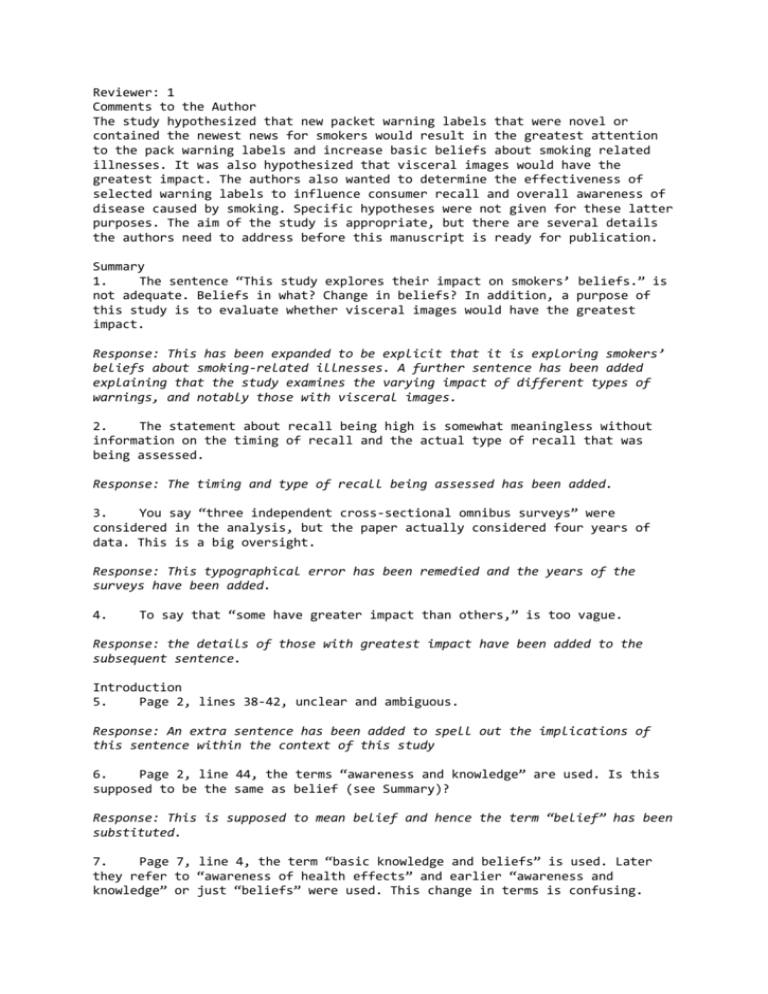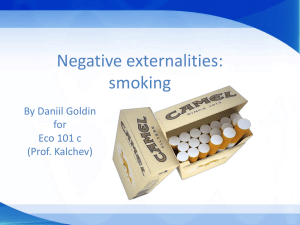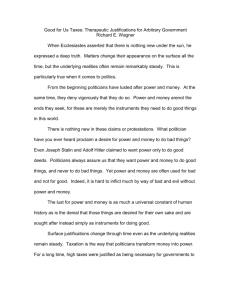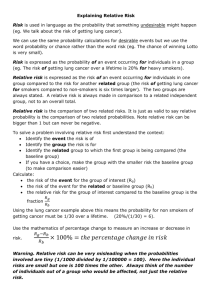Reviewer: 1 Comments to the Author The study hypothesized that
advertisement

Reviewer: 1 Comments to the Author The study hypothesized that new packet warning labels that were novel or contained the newest news for smokers would result in the greatest attention to the pack warning labels and increase basic beliefs about smoking related illnesses. It was also hypothesized that visceral images would have the greatest impact. The authors also wanted to determine the effectiveness of selected warning labels to influence consumer recall and overall awareness of disease caused by smoking. Specific hypotheses were not given for these latter purposes. The aim of the study is appropriate, but there are several details the authors need to address before this manuscript is ready for publication. Summary 1. The sentence “This study explores their impact on smokers’ beliefs.” is not adequate. Beliefs in what? Change in beliefs? In addition, a purpose of this study is to evaluate whether visceral images would have the greatest impact. Response: This has been expanded to be explicit that it is exploring smokers’ beliefs about smoking-related illnesses. A further sentence has been added explaining that the study examines the varying impact of different types of warnings, and notably those with visceral images. 2. The statement about recall being high is somewhat meaningless without information on the timing of recall and the actual type of recall that was being assessed. Response: The timing and type of recall being assessed has been added. 3. You say “three independent cross-sectional omnibus surveys” were considered in the analysis, but the paper actually considered four years of data. This is a big oversight. Response: This typographical error has been remedied and the years of the surveys have been added. 4. To say that “some have greater impact than others,” is too vague. Response: the details of those with greatest impact have been added to the subsequent sentence. Introduction 5. Page 2, lines 38-42, unclear and ambiguous. Response: An extra sentence has been added to spell out the implications of this sentence within the context of this study 6. Page 2, line 44, the terms “awareness and knowledge” are used. Is this supposed to be the same as belief (see Summary)? Response: This is supposed to mean belief and hence the term “belief” has been substituted. 7. Page 7, line 4, the term “basic knowledge and beliefs” is used. Later they refer to “awareness of health effects” and earlier “awareness and knowledge” or just “beliefs” were used. This change in terms is confusing. Response: All these instances of changing terminology have been removed and the term “belief” is used universally. 8. The hypothesis is that novel or new information about smoking will result in the greatest attention to the pack warnings. What is new or novel to one person may not be to another. How will this issue be addressed? Response: A new paragraph explaining how newness or novelty is assessed has been added to the end of the methods section. Newness or novelty is measured at the population level. It may be the case that some smokers may have been exposed to information in the past about messages that are classified here as “new”, but this study is one of average population impact of population-based communication. 9. In general, the Introduction is a lengthy literature review that could be shorted. Some of this information could fit better in the Discussion. Response: A substantial section of the introduction has been removed. Methods 10. How do you know that the surveys were representative? Response rates were 70% or less, and the response rate for 2008 was not even given. In addition, on page 10 it says that only 9% of the respondents were male. Response: Data were weighted by household size, age, gender and local government area, so that estimates would reflect the South Australian population. The response rate for the 2008 study has been added. 49% of the respondents were male. This typographical error has been fixed. New analyses have been undertaken and included to look for biases between samples 11. The Statistical Analysis section is not adequate. What statistical analyses will be performed and was SUDDAN used to take into account the complex sampling scheme? Response: The statistical analyses were originally done using SPSS. They have now been completely redone using STATA v10.0. Like SUDAAN, STATA provides survey estimating tools which account for this survey design. The survey estimating tools adjust the standard errors to account for the design which involved clustering by Australian Census District, stratification (metropolitan vs rural) and data that are weighted to the population. Interyear and intra-year differences between proportions were analysed using Pearson chi-square statistics which are then converted in to F-statistics to account for survey design. Results 12. Data on 2008 were reported, but thus far, nothing is mentioned about there being 2008 data (i.e., in the Summary and Methods). Also, does paragraph 1 represent the smoking population? Response: Information about the 2008 sample has been added to the Summary and the Methods. Paragraph 1 represents the South Australian population as a whole. A phrase has been added to make this more explicit. 13. Paragraph 1. In the 2005 survey, only 9% of the total population sampled was male. Also, about 16% of the total population was classified as smokers. Representation is an issue and generalizability of the results problematic for this year. Response: In 2005, 49% of the population was male; this was a typographical error which has been fixed. In 2005, 18.7% were smokers - with 16.5% smoking manufactured cigarettes. The proportion of manufactured cigarettes is not significantly different to the proportion of smokers of manufactured cigarettes in the following years. Discussion 14. Probably the most convincing argument that the graphic warnings were effective is that recognition of cigarette packages as sources of anti-smoking ads doubled with the introduction of the new warnings. Also, control groups not used in the campaign experienced little change with each year. However, not all graphic warnings experienced a dramatic increase in recall or awareness. The study recognizes the difference, and hypothesizes as to whether or not differences in the individual advertisements are the cause, but the data does not address this. The claim that graphic warnings are effective in increasing the awareness of adverse health effects is a fairly liberal interpretation. Awareness could have increased in certain areas because of natural interest or concern in the subject matter. Response: In the first paragraph of the discussion, the phrase “contributed directly to increased awareness” has been changed to “coincided with increased awareness”. Other sources of increased awareness and chance are now acknowledged in the discussion as potential other causes before making the case (using the arguments that the reviewer notes). Reviewer: 2 Comments to the Author This is a timely study of graphic warning messages on cigarette packaging, useful to jurisdictions considering such legislation. However, it also evidences the need to keep messaging fresh, if the impact is to be maintained over time. Overall, the paper is well presented and the argument well made. It is solidly situated within existing cross-disciplinary literature and international policy on tobacco control, and is relevant to researchers and policy-makers. My main issue is with the methods section. This section feels less assured than the rest: for example, the opening line states that data were collected from "independent cross-sectional surveys", but surely they are linked in some way and, in the context of this study, should be considered a series? Otherwise, this seems to contradict the insistence (elsewhere) that knowledge and beliefs are being studied "over time" (and if they're to support the "cause and effect" statement page 13, line 40-42). Is this a separate survey, or are you using the data from ABS? The former, I'm sure, but a little more clarity would help. And on page 8, line 6, what sort of interviews? Structured, semi-structured? Also, whilst I may have missed this, where (page 8, line 12/13) does this Sth Australian Health Omnibus Survey come from, and what's its relationship to this study and to the sampling just described? This part of the section seems in all to be rather glossed over, and if we're to trust the rest, I'd like to feel a little more secure that it's a study based on sound research methods. Response: Several minor changes have been made to the methods section to try to be clearer about the tool (the South Australian Health Omnibus Surveys) and its methodology. The data were collected in the South Australian Health Omnibus Survey. The surveys are connected via their shared methodology, but each year an independent sample on the order of 3000 participants is drawn from a population of 1.5m. Changes “over time” refer to changes in the South Australian population, measured through cross-sectional surveys, not changes in a cohort. Significance testing was done for independent samples. A clarifying phrase about the sample/methodology has been added to the paragraph containing the “cause and effect” statement on (former page 13, lines 40-42). Interviews were structured – this has been noted in the Methods-sample section. Page 8, lines 40-42 - What about smokers of hand-rolled cigarettes? Any? Response: There were smokers of loose tobacco; smokers of hand-rolled cigarettes and also pipes make up the difference between all smokers and smokers of manufactured cigarettes. These smokers are not the subject of the current study because the graphic warning labels legislation applied differently to loose tobacco and manufactured cigarettes. Smokers of loose tobacco were too few in number to allow any meaningful analyses. Page 10, line 10: Query on the 9% male figure - seems very low, so is this right? And, although you say these data reflect Sth A population, you offer no comparisons by which to judge that statement. Response: 49% of the sample was male. This typographical error has been fixed. As noted in the Methods-Sample section, data in the South Australian Health Omnibus Survey are weighted to reflect the South Australian population. Finally, some additional detailed comments on the text follow - most are hardly vital, but they may help clarification and ease of reading? Page 4, line 28: "The authors" I assume refers to Borland et al, but could be mistaken for referring back, comparatively, to this paper's authors? Response: “The authors” has been replaced with Borland et al (2009) Page 6, line 1: Is "for example" right? The example that follows appears to refer to a previously unseen image, rather than used in previous social marketing campaigns. Response: This example is right, but the term “others have not” has been added to the end of both the previous sentences for clarity. Page 6, after "insert table 1 here": There may be some benefit in clarifying the references to "new". Do you mean new as in new legislation on graphic warnings, or new as in previously unseen images (as opposed to seen as part of social marketing campaigns)? Response: We mean new system of graphic warnings. A clarifying phrase has been added. Page 12, line 26: "Female smokers were also MORE likely..?" Response: Done Page 12, line 32/33: "No significant differences in recall..." yet you've just said in previous paragraphs that there were differences. Is there a some element missing in this sentence - diffs between what and what? Response: This statement is about the lack of differences across sub-groups. A clarifying phrase has been added.




